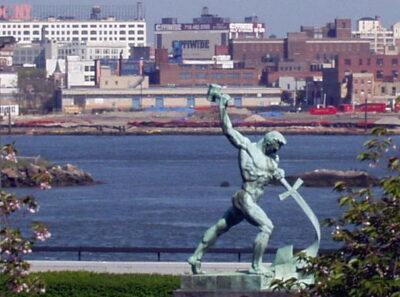See the nations turn their swords into plowshares
—Michael Jackson, “Heal the World” (1991)
They will walk behind the ploughshare,
They will put away the sword.
—Les Misérable, “Finale” (1980)

image credit commons.wikimedia.org
To End All Wars
In the United Nations garden there is a bronze statue of a man swinging a hammer with one hand at a sword that he’s holding in the other. The statue is called, “Let Us Beat Swords into Plowshares.” It’s the work of the Russian-born sculptor Evgeniy Vuchetich. According to the United Nations’ website, the statue symbolizes “man’s desire to put an end to war and convert the means of destruction into creative tools for the benefit of all mankind.” The statue, like the others in the park was gift, a donation. The donor in this case was the Soviet Union.
Secretary-General Dag Hammarskjold, in his thanks to the Soviet government, connected the statue with the United Nations Charter and with Scripture: “The ancient dream of mankind, reflected in the words of Isaiah, to which this statue gives symbolic expression is the dream inspiring also the Charter.” As Hammarskjold knew, the image of swords turned into plowshares is biblical in origin. It appears twice in the prophets in almost identical words—in Isaiah 2 and Micah 4. Here is Micah’s version:
And he shall judge among many people, and rebuke strong nations afar off; and they shall beat their swords into plowshares, and their spears into pruninghooks: nation shall not lift up a sword against nation, neither shall they learn war any more (4:3).
The Context: The Time Frame
Isaiah and Micah both set the fulfillment of their prophecy “in the last days.” The last days are either the last days of the Old Covenant—the days when Messiah would appear—or the days that begin with and follow His advent, that stretch from His first coming to His return in glory. For according to Peter, the last days had already begun when the Holy Spirit descended at Pentecost (Acts 2:17). For Paul, “the ends of the ages” had come upon the New Testament Church (1 Cor. 10:11, NKJV). The writer of Hebrews says that God revealed Himself in His Son “in these last days” (Heb. 1:2). And John, warning of the antichrist who were already in evidence before Jerusalem fell, wrote bluntly, “It is the last hour” (1 Jn. 2:18, NKJV).
The last days belong to history and to the reign of Christ in saving grace. They have no reference to eternity or to heaven, except insofar as heaven is acting on earth and within history. The prophecy of Micah and Isaiah is about our world and its future.
Context: The Mountain
According to Isaiah, “And it shall come to pass in the last days, that the mountain of the LORD’S house shall be established in the top of the mountains, and shall be exalted above the hills; and all nations shall flow unto it”.
Zion was the mount in Jerusalem where David set up his throne and a tabernacle for the Ark of the Covenant. When David’s psalms speak of Zion, this is assumed. Even after Solomon moved the Ark and the worship of Yahweh to Mount Moriah, the psalmists and prophets still spoke of God’s residence and throne as Mount Zion. In fact, Zion becomes a synonym for Jerusalem or, more broadly, for the whole covenant people. Zion is the city of God where Messiah sits enthroned in the midst of His people (Ps. 2; 48).
In the New Testament, Zion (Sion) is still the city of God and the throne of Messiah. But the focus of the New Testament writers is no longer the earthly city of Jerusalem:
But ye are come unto mount Sion, and unto the city of the living God, the heavenly Jerusalem, and to an innumerable company of angels, to the general assembly and church of the firstborn . . . and to Jesus the mediator of the new covenant (Heb. 12:22-24).
And I looked, and, lo, a Lamb stood on the mount Sion, and with him an hundred forty and four thousand . . . which were redeemed from the earth. (Rev. 14:1-2).
Zion is the community of the redeemed, the Jerusalem of the New Covenant. It is this Zion of the last days that Isaiah and Micah see exalted above all other mountains and hills (kingdoms).
Context: The Action
Two things happen because Zion is established and exalted: Nations and peoples stream upward into Zion, and the law-word of God pours out (Isa. 2:3; Mic. 4:2). The second is the result of the first.
The nations, the peoples of the world, hear God’s word as it comes from His Church, and in consequence encourage one another to worship Him and keep His commandments. This underscores the centrality of gospel preaching in the New Covenant age. Edward Young writes:
Two points must be stressed. First, God and God alone can teach the truth, for He only is the source and foundation of truth. Hence, those who proclaim the Word of God must exercise supreme care that what they preach is the Word of God. This can be accomplished only when the messenger bases his message squarely upon and make it consonant with the written Word of God, the Bible. When the minister preaches, God must be heard. Secondly, this passage teaches that what unbelievers need above all else is teaching or doctrine. What blinds the understanding of men is ignorance, and ignorance can only be dispelled by truth. Hence the missionary and evangelistic activities of the church must be doctrinal in character (105).
The two texts say that “all nations” and “many peoples” will flow to God’s mountain. The idea isn’t “some people from every nation,” let alone “a great many people.” What the prophets see is all the nations and peoples of the world as collective or covenantal entities streaming into the Messiah’s kingdom. Anything less won’t support what happens next.
Swords into Plowshares
When God, by His law and historical sanctions, judges, admonishes, and rebukes the nations of the earth, a remarkable thing happens. The nations abandon the art and technology of war. They turn the energies and resources they once spent on war into production—in the image here, agricultural production. They beat their swords into plowshares. They stop fighting. The whole world enjoys peace. Micah takes the prophecy a bit farther and shows us a world where every man can sit at peace under his own vine or fig tree (4:4).
In short, the prophets say that peace will come to the world when the nations receive the word of God, give themselves to the worship of God, walk in His laws, and submit to His judgment and correction. Furthermore, the prophets say this will happen before Jesus returns. It will happen as the Church faithfully declares God’s word to all the peoples of the earth. What the prophets don’t give us is an exact timeline or a terminus ad quem. We aren’t told how long this will take, only that God will accomplish it.
Is Peace Possible?
For the last hundred years or so, the general response of commentators has been, “But that’s not possible!” Their objections seem to be of three sorts. First, man is sinful. He can’t make peace. Utopia is impossible. Any offer of world peace seems more like a promise from the antichrist than from the gospel. Second, the Bible says there will always be wars; that the last days will be a time of tribulation and declining faith. Third, it hasn’t happened yet, and we’re out of time.
The first objection is good as far as it goes. Man is indeed a sinner, and he most certainly can’t bring peace to earth on his own terms or by his powers. But these prophecies are about the gospel; they’re about what Jesus Christ can do through the Spirit-empowered preaching of the word of God. Jesus can change men’s heart; He can teach them to stop killing each other. The prophecies don’t speak of sinless men or utopian nations. They speak of large numbers of people knowing Christ and obeying Him. There’s nothing unbiblical or strange about this.
The second objection simply isn’t true. These prophecies say exactly the opposite. It is true that Paul warns us that “perilous times” will come in the last days 2 Tim. 3:1ff). But in the context, he’s speaking about his own time (v. 5). And since the apostolic age, there have been many perilous times. Paul was right. But the Great Tribulation and Days of Vengeance that Christ prophesied in His Olivet Discourse belonged to that generation, as Jesus said in no uncertain terms (Matt. 23:36; 24:34; Mark 13:30; Luke 21:32).
The third objection assumes that we know God’s timetable for history. It also assumes (probably) that our own age is terribly significant and that there can’t be much more to God’s story. This at best is naïveté. For nearly two thousand years believers have been certain that their generation will be the last. So far, they’ve all been wrong. Obviously, God isn’t in a hurry.
The Progress of Peace
Even so careful a commentator as John Calvin balked at the terms of this prophecy and pushed its fulfillment “in its full extent” into eternity beyond Christ’s return. However, he did understand the progressive nature of Christ’s victory in history and the peace that generally follows that victory. He writes:
Would that Christ reigned entirely in us! for then would peace also have its perfect influence. But since we are still widely distant from the perfection of that peaceful reign, we must always think of making progress; and it is excessive folly not to consider that the kingdom of Christ here is only beginning.
Long before Calvin, Justin Martyr (d. 165), in his Dialogue with Trypho (CX), wrote this:
. . . we who were filled with war, and mutual slaughter, and every wickedness, have each through the whole earth changed our warlike weapons,—our swords into plough shares, and our spears into implement of tillage,—and we cultivate piety, righteousness, philanthropy, faith, and hope, which we have from the Father Himself through Him who was crucified.
Justin himself died a martyr, but he still believed that the gospel has seriously curtailed violence and war in his own age. Athanasius, the great champion of orthodoxy at Nicea, was repeatedly exiled for his faith. Yet he wrote this in On the Incarnation of the Word:
. . . even now those barbarians who have an innate savagery of manners, while they still sacrifice to the idols of their country, are mad against one another, and cannot endure to be a single hour without weapons: but when they hear the teaching of Christ, straightway instead of fighting they turn to husbandry, and instead of arming their hands they raise them in prayer, and in a word, in place of fighting among themselves, henceforth they arm against the devil and against evil spirits, subduing these by self-restrain and virtue of soul. (52)
Conclusion
For the last one hundred and fifty years, the states that make up the American union haven’t gone to war with one another. The United State hasn’t fought a war against Mexico for one hundred and seventy years. She hasn’t fought with Canada since the War of 1812.
Shall we say that Americans are simply better tempered, less aggressive, less given to violence than other peoples? Probably not. But the gospel has exercised a significant restraint upon our national goals, selfish desires, and violent proclivities. We, as a people, know that it’s bad to kill people and take their stuff. When we go to war, we want to believe that we’re in the right—that we’re fighting for freedom, either our own or that of some underdog. But as the influence of the gospel continues to decline in American life, we can assume that our wars will continue to become more pragmatic and more frequent.
The way to greater peace isn’t through international courts, federations, or man-made laws. Jesus Christ alone is the Prince and Author of Peace. In the peace He makes between God and men is the fountain of grace that can bring peace to our world. Peace comes through grace. It is structured by God’s law. And so until the Church gets serious about the Great Commission, we will continue to hear of wars and rumors of war.
For Further Reading:
John Louth, “Isaiah’s Echo: Progress, Prophecy, and the UN Charter,” EJIL Talk!, March 27, 2013, <https://www.ejiltalk.org/isaiahs-echo-progress-prophecy-and-the-un-charter/>.
Gary DeMar and Peter Leithart, The Reduction of Christianity, A Biblical Response to David Hunt (Ft. Worth, TX/Atlanta, GA: Dominion Press/American Vision Press, 1988).
Rousas J. Rushdoony, “The Law Shall Go Forth,” in Law and Society (Vallecito, CA: Ross House, 1982).
Joseph Addison Alexander, The Prophecies of Isaiah (Grand Rapids: Zondervan Publishing House, 1953 [1846-47].
Edward J. Young, The Book of Isaiah (Grand Rapids: William B. Eerdmans Publishing Company, 1965).
 Off The Grid News Better Ideas For Off The Grid Living
Off The Grid News Better Ideas For Off The Grid Living




